Casio CTK-3000, CTK-2000 User Manual
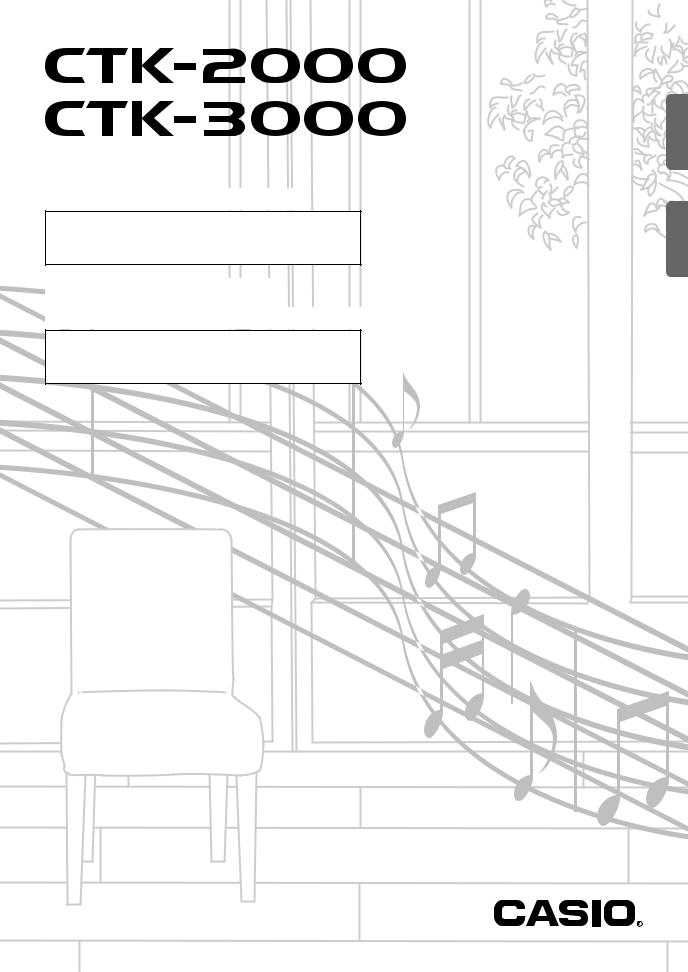
USER’S GUIDE
Please keep all information for future reference.
Safety Precautions
Before trying to use the keyboard, be sure to read the separate “Safety Precautions”.
GUÍA DEL USUARIO
Guarde toda información para tener como referencia futura.
Precauciones de seguridad
Antes de intentar usar el teclado, asegúrese de leer las “Precauciones de seguridad” separadas.
ES
English
Español
CTK2000/3000ES1B

NOTICE
This equipment has been tested and found to comply with the limits for a Class B digital device, pursuant to Part 15 of the FCC Rules. These limits are designed to provide reasonable protection against harmful interference in a residential installation. This equipment generates, uses and can radiate radio frequency energy and, if not installed and used in accordance with the instructions, may cause harmful interference to radio communications. However, there is no guarantee that interference will not occur in a particular installation. If this equipment does cause harmful interference to radio or television reception, which can be determined by turning the equipment off and on, the user is encouraged to try to correct the interference by one or more of the following measures:
•Reorient or relocate the receiving antenna.
•Increase the separation between the equipment and receiver.
•Connect the equipment into an outlet on a circuit different from that to which the receiver is connected.
•Consult the dealer or an experienced radio/TV technician for help.
FCC WARNING
Changes or modifications not expressly approved by the party responsible for compliance could void the userís authority to operate the equipment.
Declaration of Conformity
Model Number: CTK-2000/CTK-3000
Trade Name: CASIO COMPUTER CO., LTD. Responsible party: CASIO AMERICA, INC.
Address: 570 MT. PLEASANT AVENUE, DOVER, NEW JERSEY 07801 Telephone number: 973-361-5400
This device complies with Part 15 of the FCC Rules, Operation is subject to the following two conditions:
(1) This device may not cause harmful interference, and (2) this device must accept any interference received, including interference that may cause undesired operation.
Important!
Please note the following important information before using this product.
•Before using the optional AD-5 Adaptor to power the unit, be sure to check the AC Adaptor for any damage first. Carefully check the power cord for breakage, cuts, exposed wire and other serious damage. Never let children use an AC adaptor that is seriously damaged.
•Never attempt to recharge batteries.
•Do not use rechargeable batteries.
•Never mix old batteries with new ones.
•Use recommended batteries or equivalent types.
•Always make sure that positive (+) and negative (–) poles are facing correctly as indicated near the battery compartment.
•Replace batteries as soon as possible after any sign they are getting weak.
•Do not short-circuit the battery terminals.
•The product is not intended for children under 3 years.
•Use only CASIO AD-5 adaptor.
•The AC adaptor is not a toy.
•Be sure to disconnect the AC adaptor before cleaning the product.
Manufacturer:
This mark applies in EU countries only. CASIO COMPUTER CO.,LTD.
6-2, Hon-machi 1-chome, Shibuya-ku, Tokyo 151-8543, Japan
Responsible within the European Union:
CASIO EUROPE GmbH
Bornbarch 10, 22848 Norderstedt, Germany
●Company and product names used in this manual may be registered trademarks of others.
●Any reproduction of the contents of this manual, either in part or its entirety, is prohibited. Except for your own, personal use, any other use of the contents of this manual without the consent of CASIO is prohibited under copyright laws.
●IN NO EVENT SHALL CASIO BE LIABLE FOR ANY DAMAGES WHATSOEVER (INCLUDING, WITHOUT LIMITATION, DAMAGES FOR LOSS OF PROFITS, BUSINESS INTERRUPTION, LOSS OF INFORMATION) ARISING OUT OF THE USE OF OR INABILITY TO USE THIS MANUAL OR PRODUCT, EVEN IF CASIO HAS BEEN ADVISED OF THE POSSIBILITY OF SUCH DAMAGES.
●The contents of this manual are subject to change without notice.


 Contents
Contents
General Guide ............................. |
E-2 |
Using the 10-key Pad (bn) ..................................... |
E-4 |
Using the Setting Button (3)................................. |
E-4 |
Getting Ready to Play ................ |
E-5 |
Preparing the Music Stand ..................................... |
E-5 |
Power Supply ......................................................... |
E-5 |
Playing the Digital Keyboard..... |
E-6 |
Turning on Power and Playing ............................... |
E-6 |
Using Headphones ................................................. |
E-6 |
Changing Keyboard Response to |
|
Touch Pressure (Touch Response) |
|
(CTK-3000 only) ..................................................... |
E-7 |
Using the Metronome ............................................. |
E-8 |
Controlling the |
|
Keyboard Sounds....................... |
E-9 |
Select from a variety of musical |
|
instrument sounds .................................................. |
E-9 |
Using Reverb........................................................ |
E-10 |
Using a Pedal ....................................................... |
E-10 |
Changing the Pitch |
|
(Transpose, Tuning) ............................................. |
E-11 |
Using the Pitch Bend Wheel to |
|
Shift the Pitch of Notes (CTK-3000 Only)............. |
E-11 |
Sampling a Sound and Playing It |
|
on the Keyboard (Sampling)................................. |
E-12 |
Using a Sampled Sound in a Rhythm |
|
(Drum Assign)....................................................... |
E-14 |
Playing Built-in Songs ............. |
E-15 |
Playing the Demo Songs ...................................... |
E-15 |
Playing Back a Particular Song ............................ |
E-15 |
Using Built-in Songs to |
|
Master Keyboard Play .............. |
E-19 |
Phrases ................................................................ |
E-19 |
Step Up Lesson Flow ........................................... |
E-19 |
Selecting the Song, Phrase, and |
|
Part You Want to Practice .................................... |
E-20 |
Lessons 1, 2, and 3 .............................................. |
E-21 |
Lesson Settings .................................................... |
E-22 |
Using Auto Step Up Lesson ................................. |
E-23 |
Music Challenge |
|
Keyboard Game ........................ |
E-25 |
Using Auto Accompaniment.... |
E-27 |
Playing the Rhythm Part Only .............................. |
E-27 |
Playing All Parts ................................................... |
E-28 |
Using Auto Accompaniment Effectively................ |
E-30 |
Using One-Touch Preset ...................................... |
E-31 |
Connecting External Devices..... |
E-32 |
Connecting a Computer........................................ |
E-32 |
MIDI Settings ........................................................ |
E-33 |
Connecting to Audio Equipment ........................... |
E-35 |
Reference................................... |
E-36 |
Troubleshooting.................................................... |
E-36 |
Specifications ....................................................... |
E-38 |
Operating Precautions.......................................... |
E-39 |
Song List............................................................... |
E-40 |
Chord Chart .......................................................... |
E-41 |
MIDI Implementation Chart
English
Included Accessories |
|
Separately Available Accessories |
● Music Stand |
|
• You can get information about accessories that |
● Song Book |
|
are separately for this product from the CASIO |
● Leaflets |
|
keyboard catalog available from your retailer, and |
• Safety Precautions |
|
from the CASIO website at the following URL. |
• Appendix |
|
|
• Other (Warranty, etc.) |
|
http://world.casio.com/ |
Items included as accessories are subject to change without notice. |
|
|
|
|
|
E-1
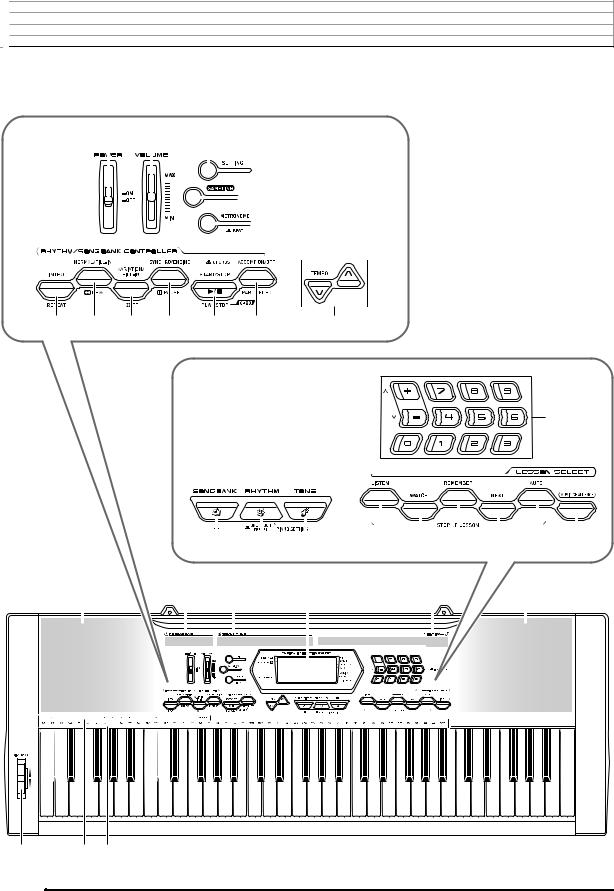

 General Guide
General Guide
•In this manual, the term “Digital Keyboard” refers to the CTK-2000/CTK-3000.
•Illustrations in this User’s Guide show the CTK-3000.
•In this manual, buttons and other controllers are identified using the numbers shown below.
1 |
2 |
3 |
4 5 |
||||||||||||
|
|
|
|
|
|
|
|
|
|
|
|
|
|
|
|
|
|
|
|
|
|
|
|
|
|
|
|
|
|
|
|
|
|
|
|
|
|
|
|
|
|
|
|
|
|
|
|
|
|
|
|
|
|
|
|
|
|
|
|
|
|
|
|
|
|
|
|
|
|
|
|
|
|
|
|
|
|
|
|
|
|
|
|
|
|
|
|
|
|
|
|
|
|
|
|
|
|
|
|
|
|
|
|
|
|
|
|
|
|
|
|
6 7 8 9 bk bl |
bm |
bn
|
|
|
|
|
|
|
|
|
|
|
|
|
|
|
|
|
|
|
|
|
|
|
|
|
|
|
|
|
|
|
|
|
|
|
|
|
|
|
|
|
|
|
|
|
|
|
|
|
|
|
|
|
|
|
|
|
|
|
|
|
|
|
|
|
|
|
|
|
|
|
|
|
|
|
|
|
|
|
|
|
|
|
|
|
|
|
|
|
|
|
|
|
|
|
|
|
|||||||||||||
|
|
|
|
|
|
|
|
|
|
|
|
|
|
|
|
|
bo |
|
bp |
|
bq |
|
|
|
|
|
br bs bt |
|
|
ck cl cm |
||||||||||||||||||||||||
|
|
|
cn |
|
|
co |
cp |
|
cq |
|
|
|
|
|
|
|
|
|
|
cr |
|
|
|
|
|
cn |
||||||||||||||||||||||||||||
|
|
|
|
|
|
|
|
|
|
|
|
|
|
|
|
|
|
|
|
|
|
|
|
|
|
|
|
|
|
|
|
|
|
|
|
|
|
|
|
|
|
|
|
|
|
|
|
|
|
|
|
|
|
|
|
|
|
|
|
|
|
|
|
|
|
|
|
|
|
|
|
|
|
|
|
|
|
|
|
|
|
|
|
|
|
|
|
|
|
|
|
|
|
|
|
|
|
|
|
|
|
|
|
|
|
|
|
|
|
|
|
|
|
|
|
|
|
|
|
|
|
|
|
|
|
|
|
|
|
|
|
|
|
|
|
|
|
|
|
|
|
|
|
|
|
|
|
|
|
|
|
|
|
|
|
|
|
|
|
|
|
|
|
|
|
|
|
|
|
|
|
|
|
|
|
|
|
|
|
|
|
|
|
|
|
|
|
|
|
|
|
|
|
|
|
|
|
|
|
|
|
|
|
|
|
|
|
|
|
|
|
|
|
|
|
|
|
|
|
|
|
|
|
|
|
|
|
|
|
|
|
|
|
|
|
|
|
|
|
|
|
|
|
|
|
|
|
|
|
|
|
|
|
|
|
|
|
|
|
|
|
|
|
|
|
|
|
|
|
|
|
|
|
|
|
|
|
|
|
|
|
|
|
|
|
|
|
|
|
|
|
|
|
|
|
|
|
|
|
|
|
|
|
|
|
|
|
|
|
|
|
|
|
|
|
|
|
|
|
|
|
|
|
|
|
|
|
|
|
|
|
|
|
|
|
|
|
|
|
|
|
|
|
|
|
|
|
|
|
|
|
|
|
|
|
|
|
|
|
|
|
|
|
|
|
|
|
|
|
|
|
|
|
|
|
|
|
|
|
|
|
|
|
|
|
|
|
|
|
|
|
|
|
|
|
|
|
|
|
|
|
|
|
|
|
|
|
|
|
|
|
|
|
|
|
|
|
|
|
|
|
|
|
|
|
|
|
|
|
|
|
|
|
|
|
|
|
|
|
cs |
ct dk |
E-2
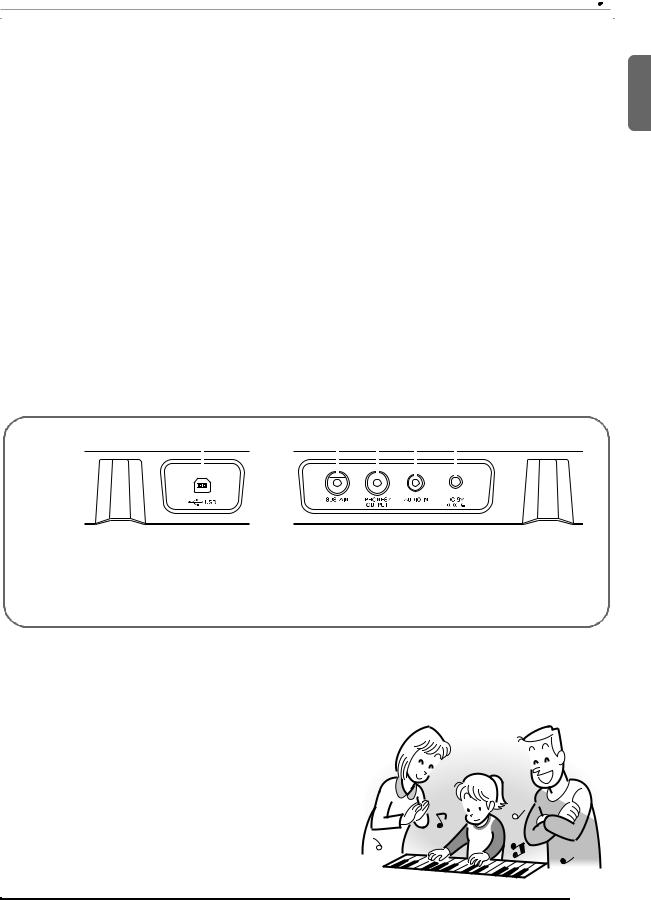
|
|
|
|
|
|
|
|
|
|
|
|
|
|
|
|
|
|
|
|
|
|
|
|
|
|
General Guide |
|
1 POWER switch E-6 |
bp RHYTHM, ONE TOUCH PRESET button |
||||||||||||
2 VOLUME slider E-6 |
|
E-9, 27, 31 |
|||||||||||
|
|
|
|
|
|
|
|
|
|||||
3 SETTING button E-4 |
bq TONE button E-6, 9 |
||||||||||||
|
|
|
|
|
|
|
|
|
|||||
4 SAMPLING button E-12 |
br LISTEN button E-21 |
||||||||||||
|
|
|
|
|
|
|
|
|
|||||
5 METRONOME button E-8 |
bs WATCH button E-21 |
||||||||||||
|
|
|
|
|
|
|
|
|
|||||
6 INTRO, REPEAT button E-16, 17, 22, 30 |
bt REMEMBER button E-22 |
||||||||||||
|
|
|
|
|
|
|
|
|
|||||
7 NORMAL/FILL-IN, REW button E-16, 20, 27, 30 |
ck NEXT button E-20 |
||||||||||||
|
|
|
|
|
|
|
|
|
|||||
8 VARIATION/FILL-IN, FF button E-16, 20, 30 |
cl AUTO button E-23 |
||||||||||||
|
|
|
|
|
|
|
|
|
|||||
9 SYNCHRO/ENDING, PAUSE button |
cm MUSIC CHALLENGE button E-25 |
||||||||||||
|
|
|
|
|
|
|
|
|
|||||
E-16, 30, 31 |
cn Speakers |
||||||||||||
bk START/STOP, PLAY/STOP button |
co Song Bank list |
||||||||||||
E-15, 16, 18, 21, 22, 27 |
cp Rhythm list |
||||||||||||
|
|
|
|
||||||||||
bl ACCOMP ON/OFF, PART SELECT button |
cq Display |
||||||||||||
E-15, 18, 20, 22, 28, 34 |
|||||||||||||
|
|
|
|
|
|
|
|
|
|||||
bm TEMPO buttons E-8, 17, 31 |
cr Tone list |
||||||||||||
|
|
|
|
|
|
|
|
|
|||||
bn Number buttons, [–]/[+] buttons E-4 |
cs PITCH BEND wheel (CTK-3000 only) E-11 |
||||||||||||
|
|
|
|
|
|
|
|
|
|||||
bo SONG BANK button E-15, 17, 20 |
ct CHORD root names E-28 |
||||||||||||
|
|
|
|
|
|
|
|
|
|||||
|
|
|
|
dk Percussion instrument list E-9 |
|||||||||
|
dl |
dm dn do dp |
|||||||||||
|
|
|
|
|
|
|
|
|
|
|
|
|
|
|
|
|
|
|
|
|
|
|
|
|
|
|
|
dl USB port E-32 |
dm SUSTAIN jack E-10 |
|
dn PHONES/OUTPUT jack E-6, 35 |
|
do AUDIO IN jack E-12, 35 |
|
dp DC 9V terminal E-5 |
English
E-3
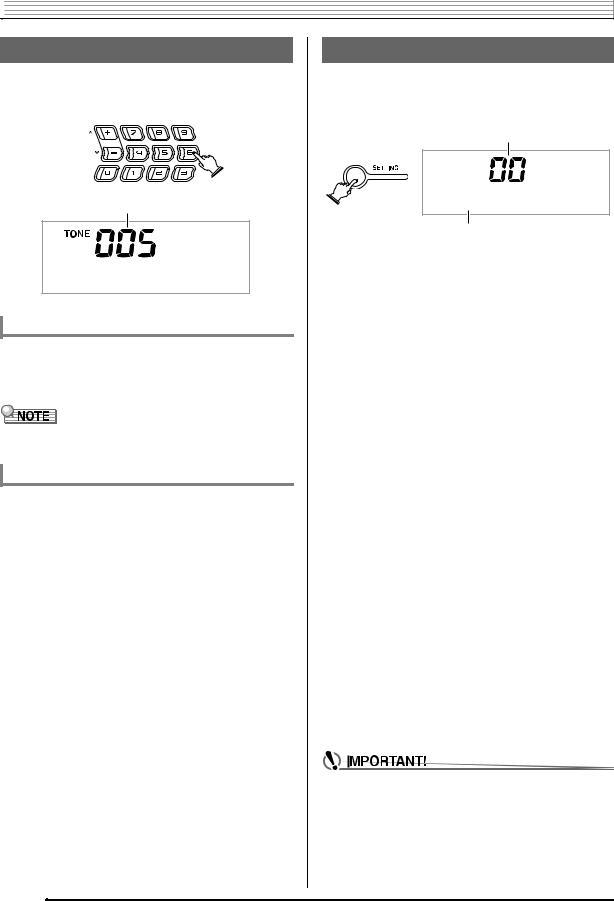

 General Guide
General Guide
Using the 10-key Pad (bn)
Use the number buttons and the [–] and [+] buttons to change the settings of the parameters that appear in the upper left area of the display.
Setting
M d e r n P n o
Number Buttons
Use the number buttons to enter numbers and values.
•Enter the same number of digits as the currently displayed value.
Example: To enter tone number 005, input 0 3 0 3 5.
•Negative values cannot be input using the number buttons. Use [+] (increase) and [–] (decrease) instead.
[–]and [+] Buttons
You can use the [+] (increase) and [–] (decrease) buttons to change the displayed number or value.
•Holding down either button scrolls the displayed setting.
•Pressing both buttons at the same time will revert to the initial default setting or the recommended setting.
Using the Setting Button (3)
Use the Setting button (3) to access settings that let you select the reverb type, pedal effect, etc.
1. Press 3.
Setting
T r a n s .
Parameter
2.Next press 3until the parameter whose setting you want to change is displayed.
Each press of 3 cycles through the available parameters.
|
Parameter |
Display |
See Page |
|
1 |
Transpose |
Trans. |
E-11 |
|
|
|
|
|
|
2 |
Accompaniment Volume |
AcompVol |
E-31 |
|
|
|
|
|
|
3 |
Song Volume |
Song Vol |
E-17 |
|
|
|
|
|
|
4 |
Touch Response |
Touch |
E-7 |
|
(CTK-3000 only) |
||||
|
|
|
||
|
|
|
|
|
5 |
Tuning |
Tune |
E-11 |
|
|
|
|
|
|
6 |
Reverb |
Reverb |
E-10 |
|
|
|
|
|
|
7 |
Voice Fingering Guide |
Speak |
E-22 |
|
|
|
|
|
|
8 |
Note Guide |
NoteGuid |
E-23 |
|
|
|
|
|
|
9 |
Performance Evaluation |
Scoring |
E-23 |
|
|
|
|
|
|
10 |
Phrase |
PhraseLn |
E-23 |
|
|
|
|
|
|
11 |
Sampling Start |
SmplAuto |
E-13 |
|
|
|
|
|
|
12 |
Keyboard Channel |
Keybd Ch |
E-33 |
|
|
|
|
|
|
13 |
Navigate Channels |
Navi. Ch |
E-33 |
|
|
|
|
|
|
14 |
Local Control |
Local |
E-34 |
|
|
|
|
|
|
15 |
Accomp Out |
AcompOut |
E-34 |
|
|
|
|
|
|
16 |
Pedal Effect |
Jack |
E-10 |
|
|
|
|
|
|
17 |
Pitch Bend Range |
Bend Rng |
E-11 |
|
|
(CTK-3000 only) |
|
|
3.When the parameter you want is displayed, use bn (10-key) to change its setting.
•The parameter setting will disappear from the upper left area of the screen if you do not perform any operation for some time.
•The tone and other parameters revert to their initial defaults whenever you turn on power (page E-6).
E-4
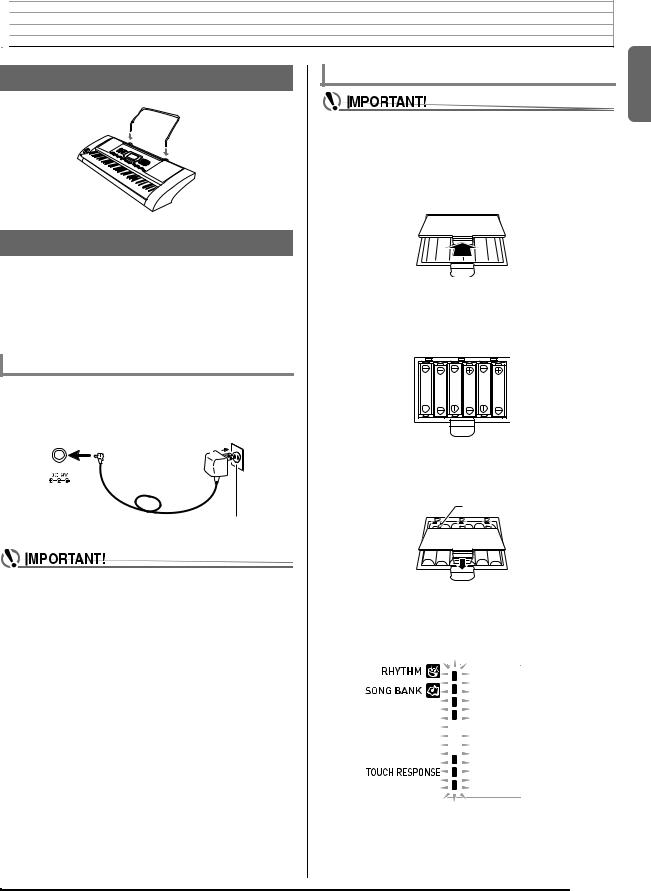

 Getting Ready to Play
Getting Ready to Play
Preparing the Music Stand
 Music stand
Music stand
Power Supply
Either an AC adaptor or batteries can be used to power this Digital Keyboard. Normally, use of AC adaptor power is recommended.
•The AD-5 AC adaptor does not come with this Digital Keyboard. Purchase it separately from your retailer. See page E-1 for information about options.
Using the AC Adaptor
Use the AD-5 AC adaptor when you want to power the Digital Keyboard from a household electrical outlet.
DC 9V terminal |
AD-5 |
||||||
|
|
|
|
|
|
|
|
|
|
|
|
|
|
|
|
|
|
|
|
|
|
|
|
|
|
|
|
|
|
|
|
Household power outlet
•Be sure to turn off Digital Keyboard power before connecting or disconnecting the AC adaptor.
Using Batteries
•Be sure to turn off power before loading batteries.
•It is up to you to prepare six commercially available AA-size batteries. Do not use oxyride batteries or any other nickel based batteries.
1.Open the battery cover on the bottom of the Digital Keyboard.
2.Load six AA-size batteries into the battery compartment.
Make sure the positive + and negative - ends of the batteries are facing as shown in the illustration.
3.Insert the tabs of the battery cover into the holes on the side of the battery compartment, and close the cover.
Tabs
■ Low Battery Indication
The indicator shown below starts to flash to let you know when battery power is low. Replace the batteries with new ones.
 Low battery indicator (flashes)
Low battery indicator (flashes)
English
E-5
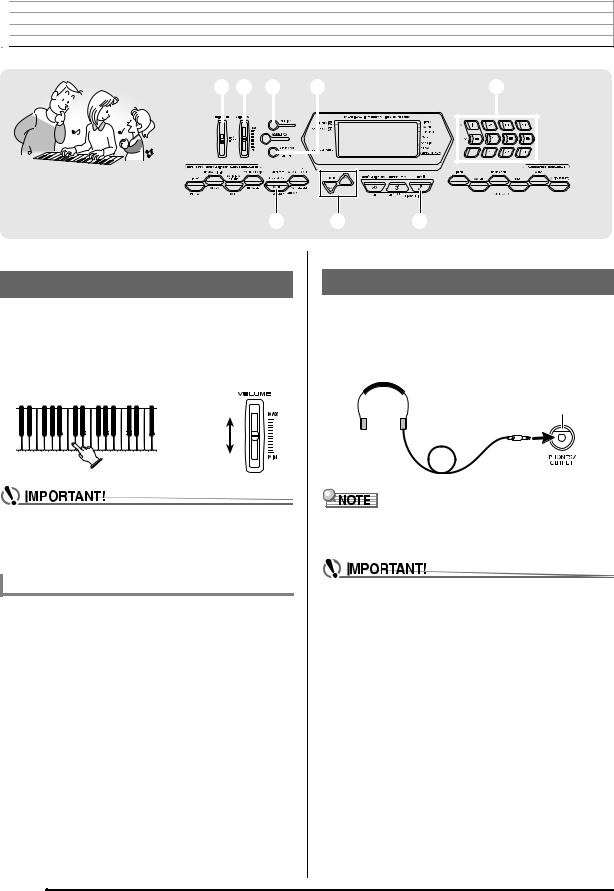

 Playing the Digital Keyboard
Playing the Digital Keyboard
1 2 3 5 |
|
|
|
bn |
|||||||
|
|
|
|
|
|
|
|
|
|
|
|
|
|
|
|
|
|
|
|
|
|
|
|
|
|
|
|
|
|
|
|
|
|
|
|
|
|
|
|
|
|
|
|
|
|
|
|
|
|
|
|
|
|
|
|
|
|
|
|
|
|
|
|
|
|
|
|
|
|
|
|
bk
Turning on Power and Playing
1.Turn on 1.
This turns on power.
2.Try playing something on the keyboard. Use 2 to adjust volume.
Increase
Decrease
•Turning off the keyboard power causes all current settings and sampled sounds (page E-12) to be cleared. The keyboard will revert to initial default settings the next time you turn it on.
Auto Power Off (Using Batteries)
While you are using batteries for power, power will turn off automatically if you do not perform any operation for about six minutes. Auto Power Off is disabled while the AC adaptor is being used for power.
■ Disabling Auto Power Off
You can disable Auto Power Off to ensure that power is not turned off automatically during a concert, etc.
1.While holding down bq, turn on power.
Auto Power Off will be disabled.
bm bq
Using Headphones
Using headphones cuts off output from the built-in speakers, which means you can practice playing even late at night without disturbing others.
•Be sure to turn down the volume level before connecting headphones.
PHONES/OUTPUT jack
•Headphones do not come with the Digital Keyboard.
•Use commercially available headphones. See page E-1 for information about options.
•Do not listen to very high volume output over headphones for long period. Doing so creates the risk of hearing damage.
•If you are using headphones that require an adaptor plug, make sure you do not leave the adaptor plugged in when removing the headphones.
E-6
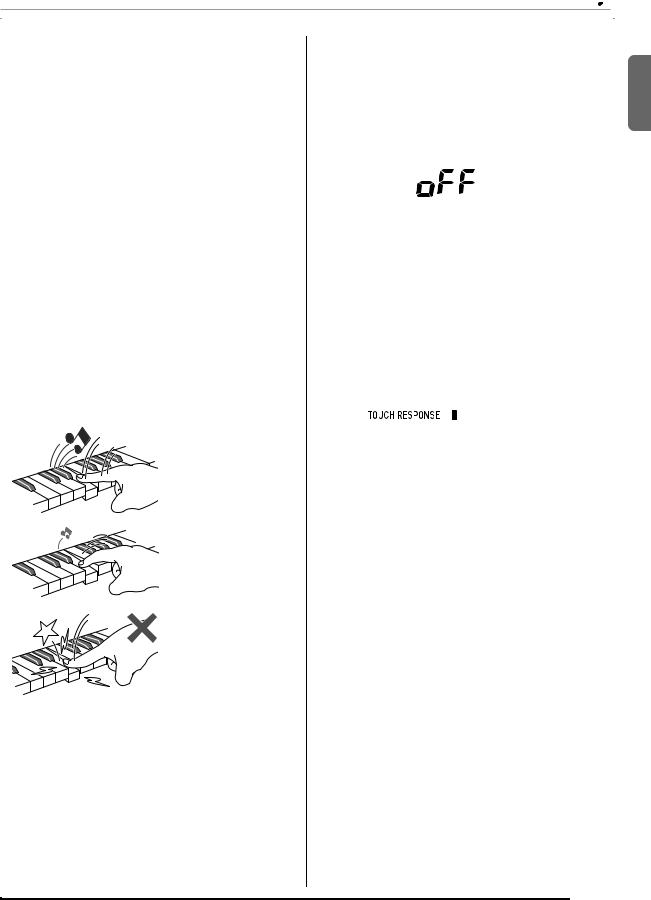
|
|
|
|
|
|
|
|
|
|
|
|
|
|
|
|
Playing the Digital Keyboard |
|||||
|
|
|
Changing Touch Response Sensitivity |
|||||||
|
Changing Keyboard Response to |
|
||||||||
|
Touch Pressure |
|
Use the procedure below to control how much the volume of |
|||||||
|
|
played notes change in accordance with playing speed. |
||||||||
|
(Touch Response) |
|
||||||||
|
|
Select the setting that best matches your playing style. |
||||||||
|
(CTK-3000 only) |
|
1. Press 3 a number of times until “Touch” |
|||||||
Touch Response alters tone volume in accordance with |
|
appears on the display (page E-4). |
||||||||
keyboard pressure (speed). This provides you some of the |
|
|
|
|
|
|
|
|
|
|
same expressivity you get on an acoustic piano. |
|
|
|
|
|
|
|
|
|
|
|
Keyboard Instrument Sound Intensity |
|
|
T o u c h |
|
|||||
|
|
|
|
|||||||
■ Sound intensity depends on the speed that keys |
|
|
|
|||||||
|
are pressed. |
|
|
|
||||||
|
|
|
|
|
|
|
|
|
||
People normally believe that the stronger the pressure applied |
|
2. Use bn (10-key) [–] and [+] keys to select one of |
||||||||
to a piano keyboard, the louder the sound. Actually, however, |
|
|||||||||
the intensity of the notes played depends on the speed at |
|
the three Touch Response sensitivity settings. |
||||||||
which keys are pressed. Notes are louder when keys are |
|
|||||||||
|
|
|
|
|
|
|
|
|
||
pressed quickly, and quieter when keys are pressed slowly. |
|
|
|
|
|
|
|
|
|
|
|
Off (oFF) |
Touch Response is turned off. Sound |
||||||||
Keeping this in mind as you play a keyboard musical |
|
|||||||||
|
|
|
volume is fixed, regardless of key press |
|||||||
instrument lets you control note volume without striving to |
|
|
|
|||||||
|
|
|
speed. |
|||||||
apply too much pressure with your fingertips. |
|
|
|
|||||||
|
Type 1 (1) |
Normal Touch Response |
||||||||
|
|
|
||||||||
■ The playability of an acoustic piano |
|
Type 2 (2) |
More sensitive Touch Response than Type 1 |
|||||||
Your Digital Keyboard provides you with key touch that is the |
|
|||||||||
|
|
|
|
|
|
|
|
|
||
next best thing to an acoustic piano. Note volume changes |
|
|
|
|
|
|
|
|
|
|
automatically in accordance with key press speed. |
|
|
|
|
|
|
Indicator disappears when |
|||
|
|
|
|
|
|
|
|
|||
|
|
|
|
|
|
|
|
|||
|
|
|
|
|
|
|
|
Touch Response is turned off. |
||
|
Pressing fast produces |
|
|
|
|
|
|
|
|
|
|
|
|
|
|
|
|
|
|
|
|
|
louder notes. |
|
|
|
|
|
|
|
|
|
Pressing slowly produces softer notes.
Do not try to use too much pressure.
English
E-7
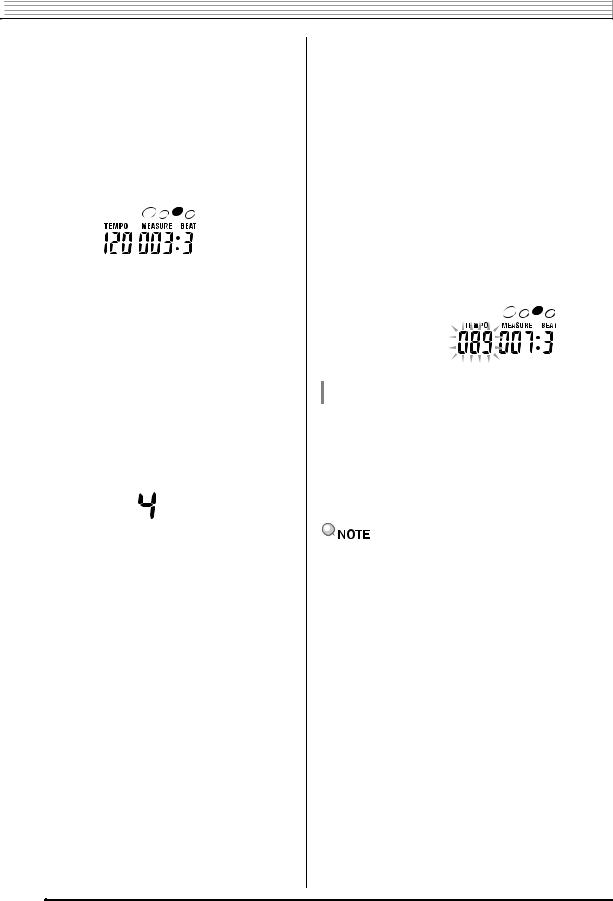

 Playing the Digital Keyboard
Playing the Digital Keyboard
|
Using the Metronome |
|
|
Changing the Metronome Tempo |
|||||||||
|
|
|
|
|
|
|
Use the following procedure to change the tempo of the |
||||||
The metronome lets you play and practice along with a steady |
|||||||||||||
|
|
metronome. |
|||||||||||
beat to help keep you on tempo. |
|
|
|||||||||||
|
|
|
|
|
|
|
|
||||||
|
Start/Stop |
|
|
1. Press bm. |
|||||||||
|
|||||||||||||
|
|
|
Use y (slower) and t (faster) to change the tempo |
||||||||||
1. Press 5. |
|
|
setting. Holding down either button changes the setting at |
||||||||||
|
|
high speed. |
|||||||||||
|
This starts the metronome. |
|
|
• |
Pressing y and t at the same time will initialize the |
||||||||
|
|
This pattern changes with each beat. |
|
|
|
tempo setting in accordance with the currently selected |
|||||||
|
|
|
|
|
song or rhythm. |
||||||||
|
|
|
|
|
|
|
• |
Pressing bm causes the tempo value to flash on the |
|||||
|
|
|
|
|
|
|
|
display. While the tempo value is flashing, you can use |
|||||
|
|
|
|
|
|
|
|
bn (10-key) to change it. |
|||||
|
|
|
|
|
|
|
|
Note that you must input leading zeros, so 89 is input |
|||||
|
|
|
|
|
|
|
|
as 089. |
|||||
|
|
|
|
|
|
|
• |
The tempo value will stop flashing if you do not perform |
|||||
|
|
|
|
|
|
||||||||
2. Press 5 again to stop the metronome. |
|
|
|
any operation for a short while. |
|||||||||
|
|
|
|
|
|
|
|
||||||
|
Changing the Beats Per Measure |
|
|
|
|
|
|
|
|
||||
|
|
|
|
|
|
|
|
|
|||||
|
|
|
|
|
|
|
|
|
|||||
You can configure the metronome to use a bell sound for the |
|
|
Tempo value (flashes) |
|
|
|
|
||||||
|
|
|
|
|
|||||||||
first beat of each measure of the song you are playing. |
|
|
|
|
|
|
|
|
|||||
•You can specify 0, or a value from 2 to 6 as the number of beat per measure.
• When playing a built-in song, the beats per measure setting |
|
Changing the Metronome Sound Volume |
||||
(which determines when the bell sounds) is configured |
The metronome volume setting is changed automatically with |
|||||
automatically for the currently selected song. |
||||||
the volume level of the currently selected Auto |
||||||
|
|
|
||||
1. Hold down 5 until the beats per measure |
Accompaniment or song. The metronome volume cannot be |
|||||
adjusted independently. |
||||||
setting screen appears on the display. |
||||||
• For information about changing the Auto Accompaniment |
||||||
|
|
|
||||
|
|
|
|
volume, see page E-31. |
||
|
|
|
• For information about changing the song volume, see page |
|||
|
|
|
|
E-17. |
||
|
B e a t |
|
|
|
|
|
|
|
|
||||
|
|
|
||||
|
|
|
||||
|
|
|
||||
• You cannot adjust the balance between the metronome |
||||||
• If you do not perform any operation for after the beats |
|
and note volume during Auto Accompaniment and built-in |
||||
|
tune play. |
|||||
per measure setting screen appears, the display will |
|
|||||
|
|
|
||||
return to the screen displayed before you pressed 5. |
|
|
|
|||
2.Use bn (10-key) to enter the number of beats per measure.
•The bell will not sound if you specify 0 for this setting. In this case, all beats are indicated by a click sound. This setting lets you practice with a steady beat, without worrying how many beats there are in each measure.
E-8
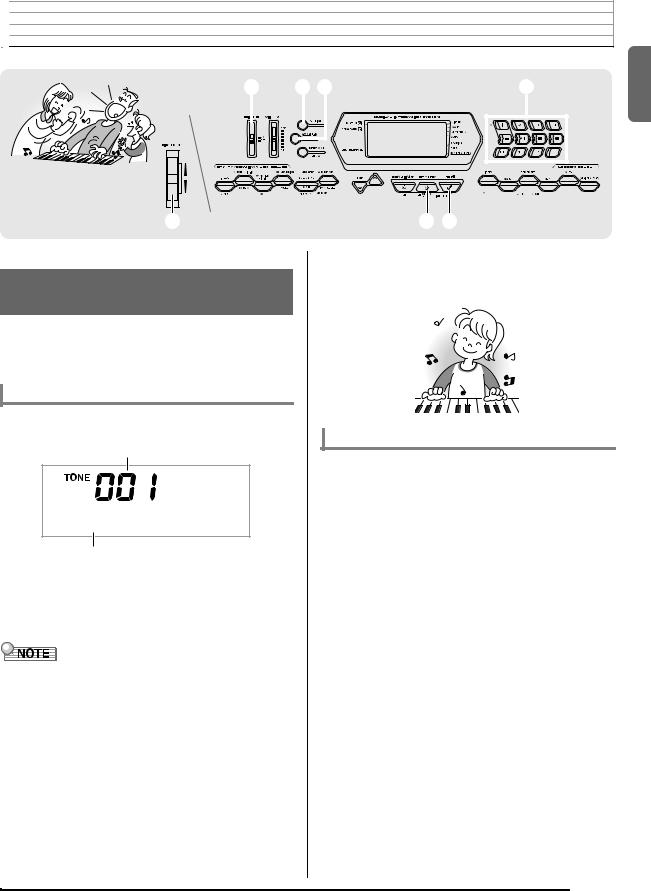

 Controlling the Keyboard Sounds
Controlling the Keyboard Sounds
1 3 4 |
|
|
|
|
bn |
|||||
|
|
|
|
|
|
|
|
|
|
|
|
|
|
|
|
|
|
|
|
|
|
|
|
|
|
|
|
|
|
|
|
|
|
|
|
|
|
|
|
|
|
|
|
|
|
|
|
|
|
|
|
|
|
|
|
|
|
|
|
|
|
|
|
|
|
cs |
bp bq |
Select from a variety of musical instrument sounds
Your Digital Keyboard lets you select tones for a wide variety of musical instrument sounds, including violin, flute, orchestra, and more. Even the same song sound takes on a different feel by changing the instrument type.
To select an instrument for playing
1. Press bq.
Tone number
S t . G r P n o
Tone name
2.Use bn (10-key) to select the tone number you want.
The corresponding tone number and tone name will appear on the screen.
•See the separate “Appendix” for a complete list of available tones.
•You also can find out instrument numbers using the tone groups printed on the Digital Keyboard’s console.
•Use the number buttons to enter the tone number. Specify three digits for the tone number.
Example: To select 001, enter 0 3 0 3 1.
•When one of the drum sets is selected (tone numbers 395 through 400), each keyboard key is assigned a different percussion sound.
3.Try playing something on the keyboard.
The tone of the instrument you selected will sound.
Playing with a Piano Tone (Piano Setup)
1.Press bp and bq at the same time.
This selects the grand piano tone.
Settings |
|
Tone Number: |
“001” |
Reverb: |
“06” |
Transpose: |
00 |
Touch Response: Off: Returns to initial default
|
On: No change |
Pedal Effect: |
SUS |
Rhythm Number: |
“131” |
Accompaniment: |
Rhythm part only |
Local Control: |
On |
Drum Assign: |
Off |
English
E-9
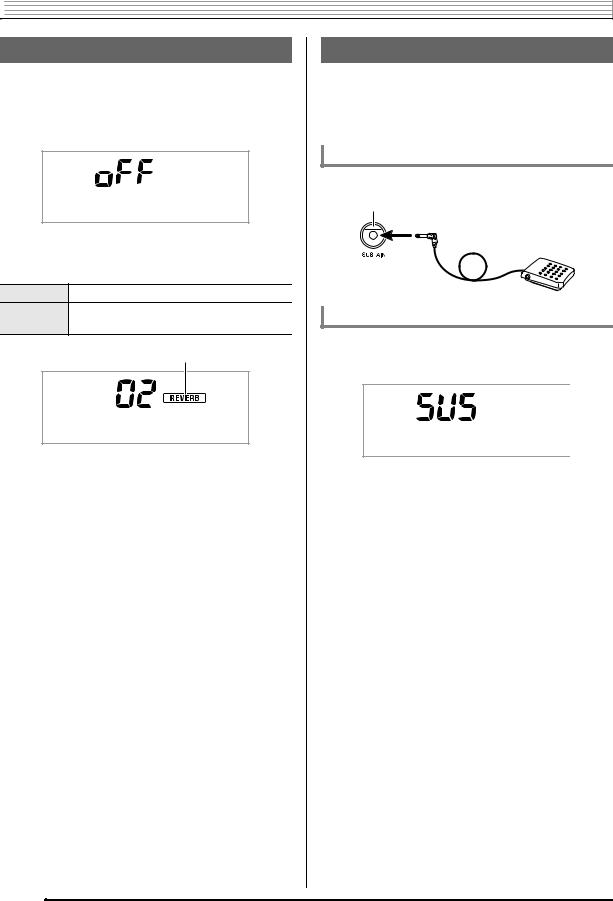

 Controlling the Keyboard Sounds
Controlling the Keyboard Sounds
Using Reverb
Reverb adds reverberation to notes. You can change the duration of the reverb.
1.Press 3 a number of times until “Reverb” appears on the display (page E-4).
R e v e r b
2.Use the bn(10-key) [–] and [+] keys to select the reverb setting you want.
Off (oFF) Turns off reverb.
1 to 10 The larger the number selected, the longer the reverb duration.
Indicator disappears when reverb is turned off.
R e v e r b
Using a Pedal
A pedal can be used to change notes in various ways while playing.
•A pedal unit does not come with the Digital Keyboard. Purchase one separately from your retailer. See page E-1 for information about options.
Connecting a Pedal Unit
Connect an optional pedal unit.
SUSTAIN jack
Selecting the Pedal Effect
1.Press 3 a number of times until “Jack” appears on the display (page E-4).
J a c k
2.Use the bn(10-key) [–] and [+] keys to select the pedal effect you want.
•The following shows the available pedal effects.
Sustain |
Sustains notes played while the pedal is |
(SUS) |
depressed. Organ and other similar tone |
|
notes are sustained even if the pedal is not |
|
pressed. |
Sostenuto |
Sustains notes that are playing when the |
(SoS) |
pedal is depressed before the keyboard |
|
keys are released. |
Soft |
Slightly softens notes played while the pedal |
(SFt) |
is depressed. |
Rhythm |
Pressing the pedal starts and stops Auto |
(rHy) |
Accompaniment or song playback. |
|
|
E-10
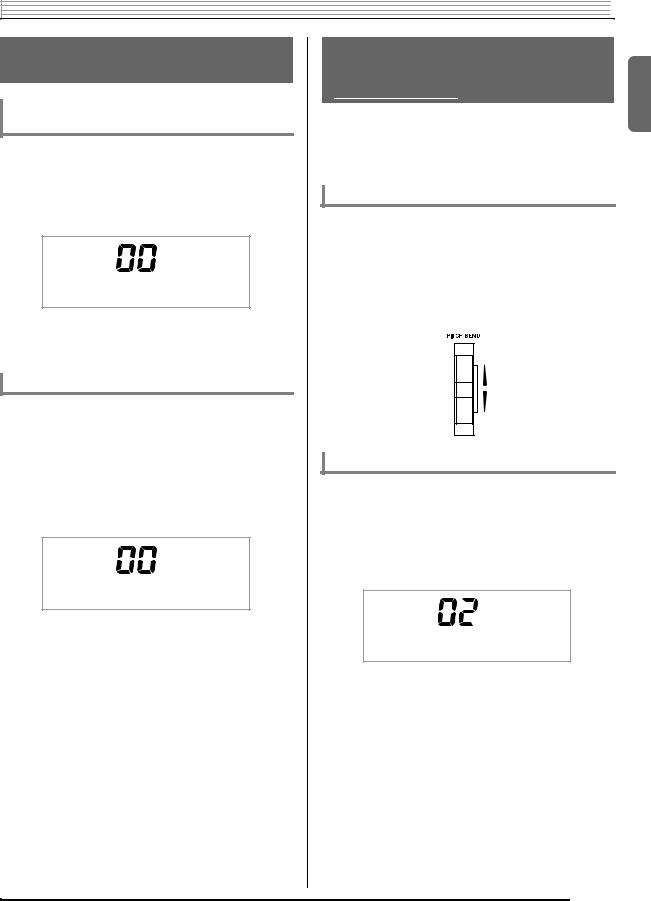
Controlling the Keyboard Sounds 

Changing the Pitch
(Transpose, Tuning)
Changing the Pitch in Semitone Steps (Transpose)
The transpose feature lets you change the pitch, in semitone steps. A simple operation lets you instantly change the pitch to match that of a singer.
• The transpose setting range is –12 to +12 semitones.
1. Press 3.
T r a n s .
2.Use the bn(10-key) [–] and [+] keys to select the transpose setting you want.
Fine Tuning (Tuning)
Use the tuning feature when you need to adjust the pitch slightly to play along with another musical instrument. Also, some artists perform their music with slightly altered tuning. You can use the tuning feature to adjust tuning so it exactly matches a performance on a CD.
• The tuning setting range is –99 to +99 cents.
1.Press 3 a number of times until “Tune” appears on the display (page E-4).
T u n e
2.Use the bn(10-key) [–] and [+] keys to adjust the tuning.
Using the Pitch Bend Wheel to Shift the Pitch of Notes (CTK-3000 Only)
You can use the pitch bend wheel to slide the pitch of notes smoothly upwards and downwards. This technique makes it possible to produce effects that are similar to sounds produced when bending notes on a saxophone or electric guitar.
To play with the pitch bend wheel
1.While playing a note on the keyboard, rotate the pitch bend wheel on the left of the keyboard upwards or downwards.
The amount the note bends depends on how much you rotate the pitch bend wheel.
•Do not have the pitch bend wheel rotated as you turn on the keyboard.
Specifying the Pitch Bend Range
Use the following procedure to specify how much the pitch of the note changes whenever the pitch bend wheel is rotated upwards or downwards. You can specify a range from 0 to 12 semitones (one octave).
1.Press 3 a number of times until “Bend Rng” appears on the display (page E-4).
B e n d R n g
2.Use the bn (10-key) [–] and [+] keys to change the range.
English
E-11
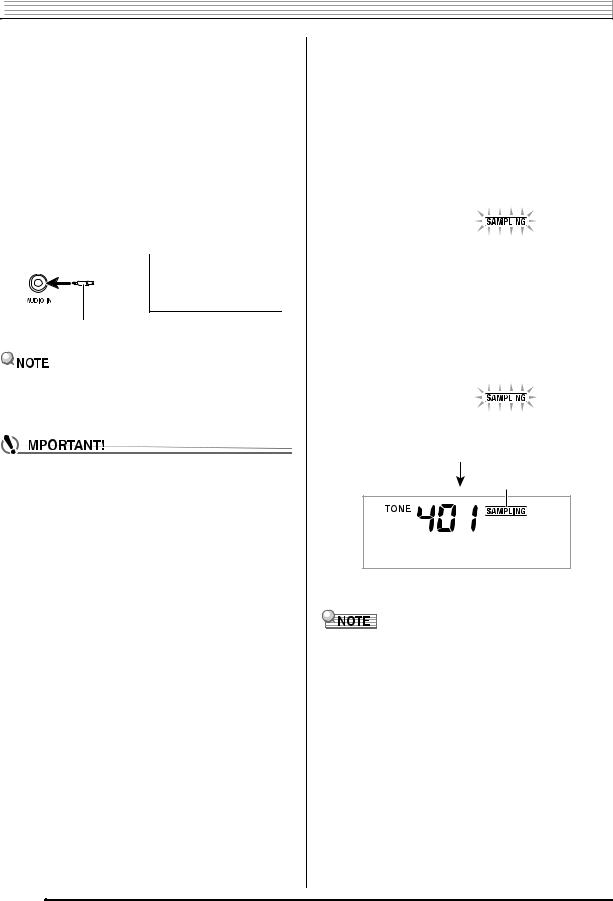

 Controlling the Keyboard Sounds
Controlling the Keyboard Sounds
|
Sampling a Sound and Playing It |
|
|
Sampling a Sound and Playing It |
|||||||||
|
on the Keyboard (Sampling) |
|
|
1. Turn the volume levels of the external device |
|||||||||
You can use the Digital Keyboard to sample a sound from a |
|
|
and Digital Keyboard down. |
||||||||||
|
|
|
|
|
|
|
|||||||
portable audio player, or other device, and then play the |
|
|
2. Turn on the external device and then the Digital |
||||||||||
sound with keyboard keys. For example, you could sample |
|
|
|||||||||||
|
|
Keyboard. |
|||||||||||
the bark of your dog and then use the sound in a melody. You |
|
|
|||||||||||
also can sample and use passages from a CD. The sampling |
|
|
3. Press 4. |
||||||||||
feature is a great way to create new sounds that are highly |
|
|
|||||||||||
creative. |
|
|
This enters record standby. |
||||||||||
|
Connection |
|
|
|
Flashes |
||||||||
|
|||||||||||||
|
|
|
|
|
|
|
|
||||||
Connect a external device. |
|
|
|
|
|
|
|
||||||
|
|
|
|
|
|
|
|||||||
|
|
|
W a i t i n g |
|
|||||||||
|
Keyboard AUDIO IN jack |
|
|
|
|
|
|
||||||
|
|
|
|
|
CD player, Cassette player, |
|
|
|
|
||||
|
|
|
|
|
|
||||||||
|
|
|
|
|
|
||||||||
|
|
|
|
|
|
|
|
|
|
|
|||
|
|
|
|
|
etc. |
|
|
|
|
|
|
|
|
4. Output the sound from the external device.
The Digital Keyboard will start sampling automatically,
Stereo mini plug
|
|
|
and stop after one second. |
|
|
|
|
|
|
|
|
What you sample is stored as tone number 401. |
|||||
|
|
|
|
|
Flashes |
|||
|
|
|
|
|
||||
|
|
|
|
|
||||
|
|
|
|
|
||||
• Connection requires commercially available connecting |
|
|||||||
|
|
|
|
|
||||
|
|
|
|
|
||||
|
cords, supplied by you. The connecting cords should have |
|
|
|
|
|
||
|
|
|
|
|
|
|||
|
a stereo mini plug on one end and a plug that matches the |
|
|
|
|
|
||
|
configuration of the external device on the other end. |
S a m p l |
i n g |
|||||
|
|
|
|
|||||
|
|
|
||||||
|
|
|
||||||
• Turn off the external device and the Digital Keyboard |
|
|
|
|
||||
|
before connecting them. |
Lights |
||||||
|
|
|
|
|
||||
• Sampled sounds are recorded in monaural.
O r i g i n a l
5. Try playing something on the keyboard.
• Sampling will not start if the volume level of the external device is too low.
• A new sample replaces sample data currently stored as tone number 401. The old data is deleted.
E-12
